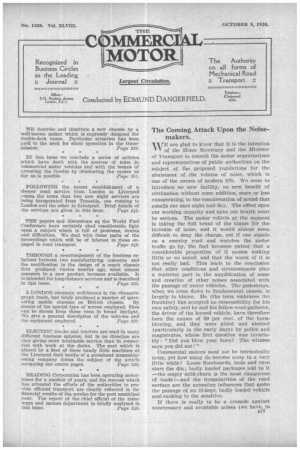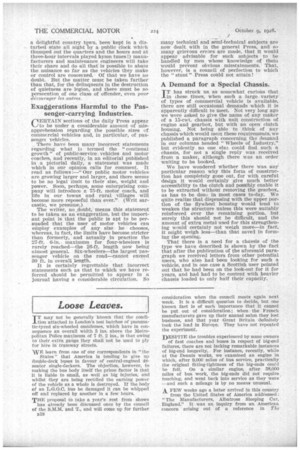The ComingAttack Upon_ the Noise makers. • . • .
Page 1

Page 2

If you've noticed an error in this article please click here to report it so we can fix it.
WE are glad to khow that it is the intention of the Home Secretaryand the Minister of Transport to consult the motor organizations and representatives of public authorities on the subject. of the proposed regulations for the abatement of the volume of noise, which is . one of the curses of modern life. We seem to introduce no new facility, no new benefit of civilization without some addition, more or less exasperating;to the'concatenation of sound that assails our ears night and day. The effect upon our working capacity and upbn our health must be serious. The motor vehicle at the moment is taking the full brunt of the blame for the increase of noise, and it would almost seem difficult to deny the charge, yet if one stands on a country road and watches the Motor traffic go by,the fact becomespatent that a considerable proportion of it passes making little or no sound, and that the worst of it is not really bad. This leads to the conclusion that other conditions and circumstances play a material part in the amplification of some and ereatron of other noises associated with the passage of motor vehicles. The pedestrian, when we come down to fundamental causes, is largely to blame, He (the term embraces the feminine) has accepted no responsibility for his own safety, and he and his fellow-wool-gatherer, the driver of the horsed vehicle, have therefore been the causes of 99 per cent, of the hornblowing, and they were aided and abetted (particularly in the early days) by police and magistrates, whose first question was invariably: "Did you blow your horn? The witness says you did not!"
Commercial motors need not be intrinsically noisy, yet how many do become noisy in a very little while! Loose floorboards, tools and Cans start the din; badly loaded packages add to it —the empty -milk-churn is the most clangorous of loads !--and the irregularities of the road surface are the actuating influences that make the passage of an ill-kept, badly loaded vehicle soul-racking to the sensitive.
If there is really to be a crusade against unnecessary and avoidable noises, (we have, in
THE COMMERCIAL MOTOR 224 a delightful country bewn, been kept in a disturbed state all night -by a public clock which thumped out the quarters and the hours and at three-hour intervals played hymn tunes!) manufacturers and maintenance engineers will take their share and do all that is possible to abate the nuisance so far as the vehicles they make or control are concerned. Of that we have no doubt. But the matter must be taken farther than that, for the delinquents in the destruction of quietness are legion, • and there must be DO persecution of one class of offender, even pour dctirager les autree.
Exaggerations Harmful to the Pas senger-carrying Industries.
CERTAIN sections of the daily Press appear to be under a considerable amount of misapprehension regarding the pos,sible sizes ef commercial vehicles and, in particular, of passencei vehicles.
There have been many incorrect statements regarding what i5 termed the "continual growth" of public-service vehicles and motor coaches, and recently, in an editorial published in a pictorial daily, a statement was made which in our opinion calls for comment. It read as follows :—" Our public motor vehicles are growing larger and larger, and there seems to be no legal limit to their size, weight and power. Soon, perhaps, some enterprising company will introduce e 75-ft. motor coach, and life in our towns and rural villages will become more reposeful than ever." (Writ sarcastic, we presume.) The writer, no edoubt, means this statement to be taken as an exaggeration, but the important point is that the public is apt to be persuaded that the user of motor vehicles can employ examples of Any size he chooses, whereas, in fact, the limits have become stricter than formerly, and actually in practice the 27-ft. 6-ine maximum for four-wheelers is rarely reached—the 26-ft. length now being almost general. Six-wheelers—the largest passenger vehicle on the road—cannot exceed 30 ft. in overall length.
It is certainly regrettable that incorrect statements such as that to which we have referred should be permitted to appear in a journal having a considerable circulation. So
many technical and semi-technical subjects are now dealt With in the general Press, and so many grievous errors are made, that it would appear advisable for such subjects to be handled by men whose knowledge of theft" would prevent obvious misstatements. That, however, is a council' of perfection to which the "stunt "Press could not •attain!
A Demand for a Special Chassis.
IT has struck us. as somewhat curious that in • these times, when such a large variety' of types of commercial vehicle is available, there are still occasional demands which it is apparently difficult to meet. Not very long ago we were asked to give the name of any maker of a 15-cwt. chassis with unit construction of engine and gearbox, but with an open clutch housing. Not being able to .think of any chassis which would meet these requirements, we published a paragraph concerning the demand in our columns headed "Wheels of Industry," but evidently no one els3 could find such a chassis, for not a single reply was received from a maker, although there was an order waiting to be booked.
We have wondered whether there was any particular reason why this form of construction has completely gone out, for with careful. design it would certainly give much better accessibility to the clutch and possibly enable it to be extracted without removing the gearbox, as has to be done in most cases to-day. We quite realize that dispensing with the upper portion of the flywheel housing would tend to weaken the structure unless this were suitably reinforced over the remaining portion, but surely this should not be difficult, and the amount of extra metal used for this strengthening would certainly not weigh more—in fact, it might weigh less—than that saved in form ing, the opening. • That there is a need for a chassis of the type we have described is shown by the fact that after the publication of the aforesaid paragraph we received letters from other potential users, who also had. been looking for such a vehicle, and in one case a Scottish user pointed out that, he had been on the look-out for it for years, and bad had to be content with heavier chassis loaded to only half their capacity.
































